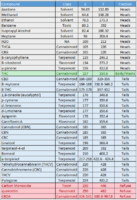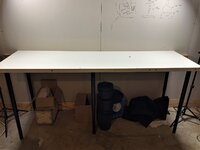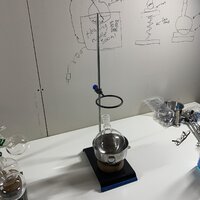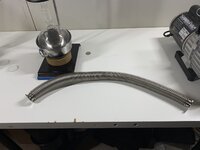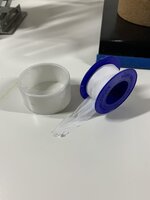- Thread starter
- #61
zeroday
Well-Known Member
Getting ready to decarb. Before I do that, I wanted to talk a little bit about vaporization temperatures. Last I read, there were over 400 different compounds in cannabis. I've only been able to gather a list of the vaporization temperatures for the ones I could find on the interwebs.
But even before vaporization temps, it's important to first explain fractions.
As it relates to the short path distillation process we are embarking on, a fraction is: A range of temperature that specific compounds will vaporize.
Very shortly, we will get the short path distillation rig setup. As we go through the run, we are essentially increasing the temperature of a solution slowly. As we do, compounds evaporate. Some of these compounds we want. Some of them we don't. Still yet, there are some that we want, but they fall too closely to an undesirable, so we bypass it.
Take a look at this image. These are the compounds I have found vaporization temperatures for.

As you can see, the Grey colored compounds will be in the Heads Fraction. The only Green colored compound is THC, so that will be the Mains/Body Fraction. Finally, the compounds colored blue are the majority of the terpenes and flavonoids, which are considered the tails. As we go through the process, we separate the three fractions into three different receiving flasks. We turn the SPD rig off when the temperature reaches ~224c or so. Anything shaded in Red is left in the boiling flask we started with, and is discarded.
Regarding CBD, the temperatures are so close that I don't see how it can be separated without much more sophisticated gear than I have access too. I'm assuming that some of it goes into the mains with the THC, and some of it goes into the tails with the terps.
Next, we'll get into the decarb.
But even before vaporization temps, it's important to first explain fractions.
As it relates to the short path distillation process we are embarking on, a fraction is: A range of temperature that specific compounds will vaporize.
Very shortly, we will get the short path distillation rig setup. As we go through the run, we are essentially increasing the temperature of a solution slowly. As we do, compounds evaporate. Some of these compounds we want. Some of them we don't. Still yet, there are some that we want, but they fall too closely to an undesirable, so we bypass it.
Take a look at this image. These are the compounds I have found vaporization temperatures for.
As you can see, the Grey colored compounds will be in the Heads Fraction. The only Green colored compound is THC, so that will be the Mains/Body Fraction. Finally, the compounds colored blue are the majority of the terpenes and flavonoids, which are considered the tails. As we go through the process, we separate the three fractions into three different receiving flasks. We turn the SPD rig off when the temperature reaches ~224c or so. Anything shaded in Red is left in the boiling flask we started with, and is discarded.
Regarding CBD, the temperatures are so close that I don't see how it can be separated without much more sophisticated gear than I have access too. I'm assuming that some of it goes into the mains with the THC, and some of it goes into the tails with the terps.
Next, we'll get into the decarb.



